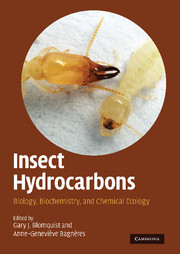Book contents
- Frontmatter
- Contents
- List of contributors
- Foreword
- Acknowledgments
- Part I Chemistry, Biochemistry, and Physiology
- 1 Introduction: history and overview of insect hydrocarbons
- 2 Structure and analysis of insect hydrocarbons
- 3 Biosynthesis of cuticular hydrocarbons
- 4 Molecular biology and genetics of hydrocarbon production
- 5 Site of synthesis, mechanism of transport and selective deposition of hydrocarbons
- 6 Cuticular lipids and water balance
- 7 Chemical taxonomy with hydrocarbons
- 8 Chemical synthesis of insect cuticular hydrocarbons
- 9 Oxygenated derivatives of hydrocarbons
- Part II Chemical Communication
- Index
3 - Biosynthesis of cuticular hydrocarbons
from Part I - Chemistry, Biochemistry, and Physiology
Published online by Cambridge University Press: 18 May 2010
- Frontmatter
- Contents
- List of contributors
- Foreword
- Acknowledgments
- Part I Chemistry, Biochemistry, and Physiology
- 1 Introduction: history and overview of insect hydrocarbons
- 2 Structure and analysis of insect hydrocarbons
- 3 Biosynthesis of cuticular hydrocarbons
- 4 Molecular biology and genetics of hydrocarbon production
- 5 Site of synthesis, mechanism of transport and selective deposition of hydrocarbons
- 6 Cuticular lipids and water balance
- 7 Chemical taxonomy with hydrocarbons
- 8 Chemical synthesis of insect cuticular hydrocarbons
- 9 Oxygenated derivatives of hydrocarbons
- Part II Chemical Communication
- Index
Summary
In vivo studies in the 1960s determined that labeled acetate was readily incorporated into insect cuticular lipids, especially hydrocarbons (Vroman et al., 1965; Lamb and Monroe, 1968; Nelson, 1969), establishing the de novo synthesis of insect hydrocarbons. Later studies with specific radio-labeled precursors and careful analysis of metabolic products determined the biosynthetic pathways for the most common components. In vivo experiments with 13C-labeled precursors extended and confirmed the conclusions based on radiochemical data. In vitro studies using microsomal preparations examined the elongation of fatty acyl-CoAs and the conversion of fatty acyl-CoAs to hydrocarbons. The mechanism of how long-chain fatty acyl-CoAs are converted to hydrocarbons has been controversial, and only recently have studies using the powerful techniques of molecular biology been applied to gaining a more complete understanding of the biosynthesis and regulation of insect hydrocarbons (Wicker-Thomas and Chertemps, Chapter 4, this book). The biosynthesis of hydrocarbons has been studied in relatively few insects, including the dipterans Musca domestica (Blomquist, 2003) and Drosophila melanogaster (Jallon and Wicker-Thomas, 2003), and considerable work has been done on cockroaches Periplaneta americana and Blattella germanica, the termite Zootermopsis angusticollis and several other insects (Nelson and Blomquist, 1995; Howard and Blomquist, 2005). Work has been done with the cabbage looper, Trichoplusia ni (Dwyer et al., 1986; de Renobales et al., 1988), southern armyworm Spodoptera eridania (Guo and Blomquist, 1991) and in cockroaches (Young and Schal, 1997) on the timing of hydrocarbon synthesis and its deposition on the insect cuticle. This chapter will concentrate on the biosynthesis of long-chain cuticular hydrocarbons.
- Type
- Chapter
- Information
- Insect HydrocarbonsBiology, Biochemistry, and Chemical Ecology, pp. 35 - 52Publisher: Cambridge University PressPrint publication year: 2010
- 47
- Cited by

